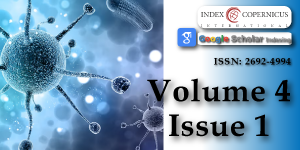COVID-19: The possible medical strategies
Main Article Content
Abstract
In late 2019, a pandemic crisis started in Wuhan, China, swept the whole world. The disease is caused by the SARS-CoV-19 virus that belongs to the corona family of viruses. The virus mainly caused failure of respiration, and led to many deaths worldwide. The main focus of research and medicine is to find more about the virus, as well as the development of effective preventive and therapeutic measures. While many trials and opinions have been published, which might support or contradict each other, this article tries to provide a simplified viewpoint about the disease. We highly recommend the therapeutic strategies to include drug combinations that can target the pathogenesis at many levels. For example, a combination of an effective anti-viral Remdesivir, soulable ACE2, and an immune modulator.
Article Details
Copyright (c) 2020 Mohamed MSA.

This work is licensed under a Creative Commons Attribution 4.0 International License.
Zhao W, Zhong Z, Xie X, Yu Q, Liu J, et al. Relation Between Chest CT Findings and Clinical Conditions of Coronavirus Disease (COVID-19) Pneumonia: A Multicenter Study. Am J Roentgenol. 2020; 214: 1072-1077. PubMed: https://www.ncbi.nlm.nih.gov/pubmed/32125873
Atallah B, Mallah SI, Al–Mahmeed W. Anticoagulation in COVID-19. Eur Heart J Cardiovasc Pharmacother. pvaa 036. PubMed: https://www.ncbi.nlm.nih.gov/pubmed/32352517
Wanga X, Yea Y, Gong H, et al. The effects of different angiotensin II type 1 receptor blockers on the regulation of the ACE-AngII-AT1 and ACE2-Ang(1–7)-Mas axes in pressure overloadinduced cardiac remodeling in male mice. J Molecular Cellu Cardiol. 2016; 97: 180-190.
Esler M, Esler D. Can Angiotensin Receptor-Blocking Drugs Perhaps Be Harmful in the COVID-19 Pandemic? J Hypertens. 2020; 38: 781-782. PubMed: https://pubmed.ncbi.nlm.nih.gov/32195824
Grein J, Ohmagari N, Shin D, et al. Compassionate Use of Remdesivir for Patients with Severe Covid-19. N Engl J Med. 2020; NE J Moa. 2007016. PubMed: https://pubmed.ncbi.nlm.nih.gov/32275812
ClinicalTrials.gov Identifier: NCT04317040
ClinicalTrials.gov Identifier: NCT04313322
Fox RI. Mechanism of Action of Hydroxychloroquine as an Antirheumatic Drug. Semin Arthritis Rheum. 1993; 23(2 Suppl 1): 82-91. PubMed: https://pubmed.ncbi.nlm.nih.gov/8278823/
Liu J, Cao R, Xu M, Wang X, et al. Hydroxychloroquine, a less toxic derivative of chloroquine, is effective in inhibiting SARS-CoV-2 infection in vitro. Cell Discovery. 2020; 6: 16. PubMed: https://pubmed.ncbi.nlm.nih.gov/32194981/
ClinicalTrials.gov Identifier: NCT04307693
Molina JM, Delaugerre C, Le Goff J, Mela-Lima B, Ponscarme D, et al. No Evidence of Rapid Antiviral Clearance or Clinical Benefit With the Combination of Hydroxychloroquine and Azithromycin in Patients With Severe COVID-19 Infection. Med Mal Infect. 2020; 50: 384. PubMed: https://www.ncbi.nlm.nih.gov/pmc/articles/PMC7195369/
Prestes TRR, Rocha NP, Miranda AS, et al. The AntiInflammatory Potential of ACE2/Angiotensin-(1-7)/Mas Receptor Axis: Evidence from Basic and Clinical Research. Curr Drug Targets. 2017; 18: 1301-1313. PubMed: https://pubmed.ncbi.nlm.nih.gov/27469342/
Zhang H, Penninger JM, Li Y, Zhong N, Slutsky AS. Angiotensin-converting Enzyme 2 (ACE2) as a SARS-CoV-2 Receptor: Molecular Mechanisms and Potential Therapeutic Target. Intensive Care Med. 2020; 46: 586-590. https://pubmed.ncbi.nlm.nih.gov/32125455/
Khan A, Benthin C, Zeno B, Albertson TE, Boyd J, et al. A Pilot Clinical Trial of Recombinant Human Angiotensin-Converting Enzyme 2 in Acute Respiratory Distress Syndrome. Crit Care. 2017; 21: 234. PubMed: https://pubmed.ncbi.nlm.nih.gov/28877748
Hung IFN, Lung KC, Tso EV, Liu R, Chung TW, et al. Triple combination of interferon beta-1b, lopinavir–ritonavir, and ribavirin in the treatment of patients admitted to hospital with COVID-19: an open-label, randomised, phase 2 trial. The Lancet. 2020; 395: 1695-1704. PubMed: https://pubmed.ncbi.nlm.nih.gov/32401715/

